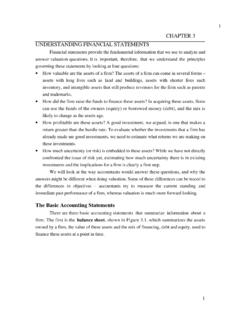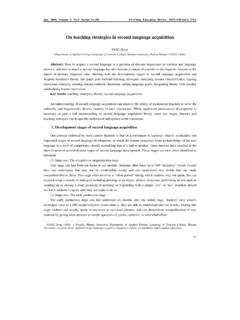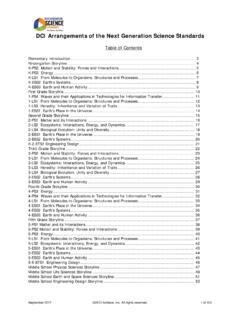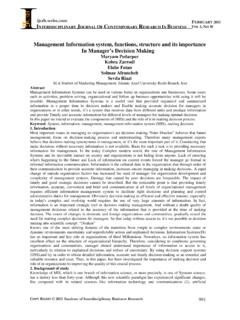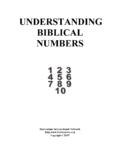Transcription of The van Hiele Model of Geometric Thinking - cuni.cz
1 The van Hiele Model of Geometric Thinking I. Vojkuvkova Charles University in Prague, Faculty of Mathematics and Physics, Prague, Czech Republic Abstract. The van Hiele theory describes how young people learn geometry. It postulates five levels of Geometric Thinking which are labeled visualization, analysis, abstraction, formal deduction and rigor. Each level uses its own language and symbols. Students or pupils pass through the levels step by step . This hierarchical order helps them to achieve better understanding and results. This article presents an overview of the Model .
2 It is focused on possibilities how to apply this theory on Czech mathematical education. Introduction Pierre van Hiele and his wife Dina van Hiele -Geldof were Dutch researchers and teachers. They had personal experience with difficulties which their students had in learning geometry. Therefore, they dealt with these problems in detail. The theory originated in their theses at the University of Utrecht in 1957. Pierre van Hiele devoted his lifetime to their theory, Dina died shortly after completing her thesis. Research based on the theory was carried out i n the Soviet Union in the 1960s.
3 Using its results, a very successful new geometry curriculum was designed in the Soviet Union. American researchers did several large studies on the van Hiele theory in the late 1970s [Usiskin, 1982 and Senk, 1985]. These studies influenced American NCTM Standards and Common Core State Standards. Van Hiele theory The theory has three aspects: the existence of levels, the properties of the levels, and the progress from one level to the next level. Van Hiele levels According to the theory, there are five levels of Thinking or understanding in geometry: Level 0 V isualization Level 1 A nalysis Level 2 Abstraction Level 3 D eduction Level 4 Rigor Originally van Hieles numbered them from 0 to 4, the USA introduced numbering from 1 to 5; later Pierre van Hiele used only 3 levels.
4 Moreover, also the level labels vary at present. Level 0 V isualization (Basic visualization or Recognition) At this level pupils use visual perception and nonverbal Thinking . They recognize Geometric figures by their shape as a whole and compare the figures with their prototypes or everyday things ( it looks like door ), categorize them ( it is / it is not ). They use simple language. They do not identify the properties of Geometric figures. Figure 1. Children at Level 0 categorize triangles. 72 WDS'12 Proceedings of Contributed Papers, Part I, 72 75, 978-80-7378-224-5 MATFYZPRESS VOJKUVKOVA : THE VAN Hiele Model OF Geometric Thinking Level 1 Analysis (Description) At this level pupils (students) start analyzing and naming properties of Geometric figures.
5 They do not see relationships between properties, they think all properties are important (= there is no difference between necessary and sufficient properties). They do not see a need for proof of facts discovered emp irically. They can measure, fold and cut paper, use Geometric software etc. Figure 2. Children at Level 1 identify only one of the properties of squares. Level 2 Abstraction (Informal deduction or Ordering or Relational) At this level pupils or students perceive relationships between properties and figures.
6 They create meaningful definitions. The y are able to give simple arguments to justify their reasoning. They can draw logical maps and diagrams. They use sketches, grid paper, Geometric SW. Figure 3. Children at Level 2 can draw a logical map of parallelograms. Pierre van Hiele wrote: My experience as a teacher of geometry convinces me that all too often, students have not yet achieved this level of informal deduction. Consequently, they are not successful in their study of the kind of geometry that Euclid created, which involves formal deduction.
7 Level 3 Deduction (Formal deduction) At this level students can give deductive Geometric proofs. They are able to differentiate between necessary and sufficient conditions. They identify which properties are implied by others. They understand the role of definitions, theorems, axioms and proofs. Level 4 Rigor At this level students understand the way how mathematical systems are established. They are able to use all types of proofs. They comprehend Euclidean and non-Euclidean geometry. They are able to describe the effect of adding or removing an axiom on a given Geometric system.
8 Properties of levels The levels have five important characteristics: Fixed sequence (order) A student cannot be at level N without having gone through level (N 1). Therefore, the student must go th rough the levels in order. Adjacency At each level, what was intrinsic in the preceding level becomes extrinsic in the current level. Distinction Each level has its own linguistic symbols and its own network of relationships connecting those symbols. The meaning of a linguistic symbol is more than its explicit definition; it includes the experiences which the speaker associates with the given symbol.
9 What may be correct at one level is not necessarily correct at another level. 73 VOJKUVKOVA : THE VAN Hiele Model OF Geometric Thinking Separation Two persons at different levels cannot understand each other. The teacher speaks a different l anguage to the student at a lower level. The van Hieles thought this property was one of the main reasons for failure in geometry. Attainment The learning process leading to complete understanding at the next level has five phases information, guided orientation, explanation, free orientation, integration, which are approximately not strictly sequential.
10 Five phases of the learning process Van Hieles believed that cognitive progress in geometry can be accelerated by instruction. The progress from one level to the next one is more dependent upon instruction than on age or maturity. They gave clear explanations of how the teacher should proceed to guide students from one level to the next. However, this process takes tens of hours. Information or Inquiry Students get the material and start discovering its structure. The teacher holds a conversation with the pupils, in well-known language symbols, in which the context he wants to use becomes clear.

